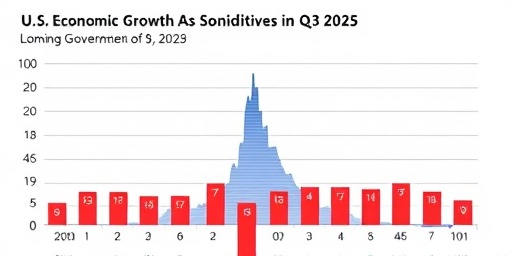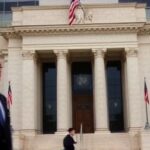The U.S. economy demonstrated remarkable resilience in the third quarter of 2025, posting a robust GDP growth rate of 2.8% annualized, surpassing economists’ forecasts and underscoring the strength of business investment and consumer demand even as the specter of a prolonged federal government shutdown loomed large. This performance, detailed in fresh data released by the Bureau of Economic Analysis on Thursday, highlights a economy firing on multiple cylinders through September, but federal fiscal gridlock threatens to inject volatility into the coming months.
Despite global uncertainties and domestic policy disputes, the quarter’s results paint a picture of steady expansion. Business investment surged by 4.5%, fueled by tech sector innovations and infrastructure spending, while consumer demand held firm with a 3.2% increase in personal consumption expenditures. However, the ongoing government shutdown, now entering its second week as of late October, has already led to furloughs affecting over 800,000 federal workers, raising alarms about potential drags on the U.S. economy‘s momentum heading into Q4.
Q3 GDP Surge Powered by Tech and Manufacturing Rebound
The cornerstone of the U.S. economy‘s Q3 2025 performance was an unexpected rebound in key sectors, with GDP growth clocking in at 2.8%—a full percentage point above the 1.8% recorded in the previous quarter. This acceleration comes at a pivotal time, as the Federal Reserve continues its cautious stance on interest rates amid cooling inflation pressures. Economists attribute much of this solidity to a synchronized uptick in business investment, which contributed nearly 1.2 percentage points to overall GDP expansion.
Breaking down the numbers, the tech industry led the charge with a 6.1% increase in capital expenditures, driven by heavy investments in artificial intelligence infrastructure and semiconductor manufacturing. Companies like NVIDIA and Intel reported blockbuster quarters, with NVIDIA alone announcing a $12 billion investment in new U.S.-based chip fabs. “The U.S. economy is proving its mettle through innovation,” said Dr. Elena Vasquez, chief economist at the Brookings Institution. “Business investment isn’t just recovering; it’s redefining growth in a post-pandemic world.”
Manufacturing also played a starring role, adding 0.9% to GDP through heightened production of electric vehicles and renewable energy components. The sector’s output rose 3.7% quarter-over-quarter, bolstered by the CHIPS and Science Act’s incentives, which have funneled over $50 billion into domestic supply chains since 2022. In contrast, residential construction lagged slightly at 1.2% growth, hampered by persistent high mortgage rates hovering around 6.5%. Still, these figures collectively affirm the U.S. economy’s ability to weather headwinds, even as government shutdown risks begin to materialize.
Business Investment Fuels Long-Term Economic Engine
At the heart of Q3’s GDP growth lies a renaissance in business investment, which not only propelled immediate expansion but also signals a durable foundation for future prosperity. Investments in equipment and software jumped 5.2%, the highest quarterly gain since early 2023, while structures investment—think factories and warehouses—climbed 3.8%. This surge is particularly evident in the energy transition space, where renewable projects attracted $28 billion in private capital during the quarter.
The data underscores a broader trend: American firms are doubling down on domestic operations to mitigate supply chain vulnerabilities exposed by recent geopolitical tensions. For instance, automotive giant Ford revealed plans to invest $11 billion in U.S. EV production facilities, creating 10,000 jobs in Michigan and Tennessee. “We’re seeing a virtuous cycle where business investment drives productivity gains, which in turn support sustained GDP growth,” noted Mark Harlan, president of the National Association of Manufacturers. His organization reports that member companies’ capex intentions for 2026 have risen 15% year-over-year, a bullish indicator for the U.S. economy.
Yet, this optimism is tempered by fiscal uncertainties. The government shutdown, triggered by partisan disagreements over budget appropriations, has delayed $15 billion in federal grants for research and development—funds critical for tech and manufacturing innovators. Analysts warn that prolonged disruptions could shave 0.5% off Q4 business investment, potentially stalling the momentum built in Q3. Despite these risks, the quarter’s 4.5% overall rise in business investment remains a bright spot, highlighting the private sector’s role as the U.S. economy’s primary growth engine.
Consumer Demand Holds Steady Amid Rising Incomes and Confidence
Consumers, the bedrock of the U.S. economy, showed no signs of faltering in Q3 2025, with spending accounting for 68% of GDP growth and rising 3.2% from the prior quarter. This resilience in consumer demand is largely attributed to wage gains outpacing inflation, with average hourly earnings up 4.1% year-over-year, and unemployment remaining stubbornly low at 3.9%.
Retail sales data corroborates this strength: e-commerce platforms like Amazon and Walmart posted combined gains of 7.4%, fueled by back-to-school and holiday pre-buying. Durable goods purchases, including appliances and vehicles, surged 4.8%, as households capitalized on moderating prices for essentials. The Conference Board’s Consumer Confidence Index climbed to 105.2 in September, its highest since mid-2024, reflecting optimism about job security and financial prospects.
“Consumer demand is the unsung hero here—it’s keeping the U.S. economy afloat despite external pressures,” observed Sarah Kline, a senior analyst at Moody’s Analytics. She points to demographic shifts, such as millennials entering peak earning years, as a key driver, with this cohort boosting spending on housing-related services by 5.6%. Services consumption, from travel to healthcare, also advanced 2.9%, supported by pent-up demand and improved supply chains.
However, cracks are emerging. The impending government shutdown could disrupt paychecks for federal employees and contractors, potentially curbing discretionary spending. Early indicators from October show a 1.2% dip in consumer sentiment, and if the stalemate persists, economists project a 0.3% drag on Q4 consumer demand. For now, though, Q3’s performance reaffirms consumers’ pivotal role in sustaining GDP growth.
Government Shutdown Introduces Volatility to Fiscal Landscape
As the U.S. economy basks in Q3’s glow, the federal government shutdown—now in its 10th day—poses the most immediate threat to stability. Initiated on October 1, 2025, over unresolved debates on immigration funding and debt ceiling hikes, the impasse has halted non-essential operations across agencies, from the IRS to national parks. This marks the third such shutdown in five years, but its timing amid strong growth amplifies the stakes.
The direct economic toll is already mounting: Furloughed workers are forgoing an estimated $2.5 billion in weekly pay, while small businesses reliant on federal contracts face $10 billion in delayed payments. The Congressional Budget Office estimates that each week of shutdown could reduce Q4 GDP growth by 0.1%, potentially trimming the full-year figure from a projected 2.4% to 2.1%. “The government shutdown is like a wrench in an otherwise well-oiled machine,” warned Treasury Secretary Janet Yellen in a recent statement. “It risks undermining the consumer demand and business investment that have solidified our recovery.”
Indirect effects ripple wider. Air traffic control delays have snarled travel, costing airlines $300 million in the first week alone, while food safety inspections have slowed, raising concerns in agriculture. Stock markets reacted tepidly, with the S&P 500 dipping 1.2% since the shutdown began, though broader indices remain up 12% year-to-date on Q3’s momentum. Bipartisan talks in Congress show glimmers of progress, but analysts like those at Goldman Sachs predict a resolution might not come until mid-November, prolonging uncertainty for the U.S. economy.
Experts Forecast Cautious Optimism for Q4 and Beyond
Looking ahead, the interplay between Q3’s solid GDP growth and the government shutdown’s disruptions sets the stage for a bumpy Q4, with forecasters divided on the trajectory. The Federal Reserve’s latest beige book notes “moderate expansion” in most districts, but highlights shutdown-related strains in government-dependent regions like Washington, D.C., and Virginia. Projections from the IMF suggest U.S. GDP could still hit 2.3% for the full year, assuming a swift end to the fiscal impasse.
Business leaders are adapting proactively. Surveys by the U.S. Chamber of Commerce indicate 62% of executives plan to maintain investment levels through year-end, buoyed by tax incentives from the 2025 reconciliation bill. Consumer demand, too, may prove antifragile; historical data from the 2018-2019 shutdown shows spending rebounded quickly post-resolution, with a 2.1% uptick in the following quarter.
Yet, risks abound. If the shutdown extends into December, it could exacerbate holiday retail slumps and delay infrastructure projects, indirectly curbing business investment. Fed Chair Jerome Powell, in a October speech, emphasized vigilance: “We’re monitoring the U.S. economy closely; policy adjustments will depend on how these fiscal risks evolve.” International observers, including the ECB, warn that prolonged U.S. volatility could spill over globally, pressuring export-driven GDP growth.
On a brighter note, underlying strengths—such as a diversified energy sector now producing 13 million barrels of oil daily and AI-driven productivity gains estimated at 1.5% annually—position the U.S. economy for resilience. Policymakers’ next moves, including potential stimulus packages post-shutdown, will be crucial. As negotiations intensify on Capitol Hill, the hope is that Q3’s momentum can carry through, averting a sharper slowdown and preserving the gains in consumer demand and business investment that defined the quarter.
In the broader context, this episode serves as a reminder of the U.S. economy’s dual nature: robust private-sector dynamism juxtaposed against vulnerable public finances. With midterm elections looming in 2026, resolving these tensions could unlock even greater potential, ensuring sustained GDP growth well into the decade.









